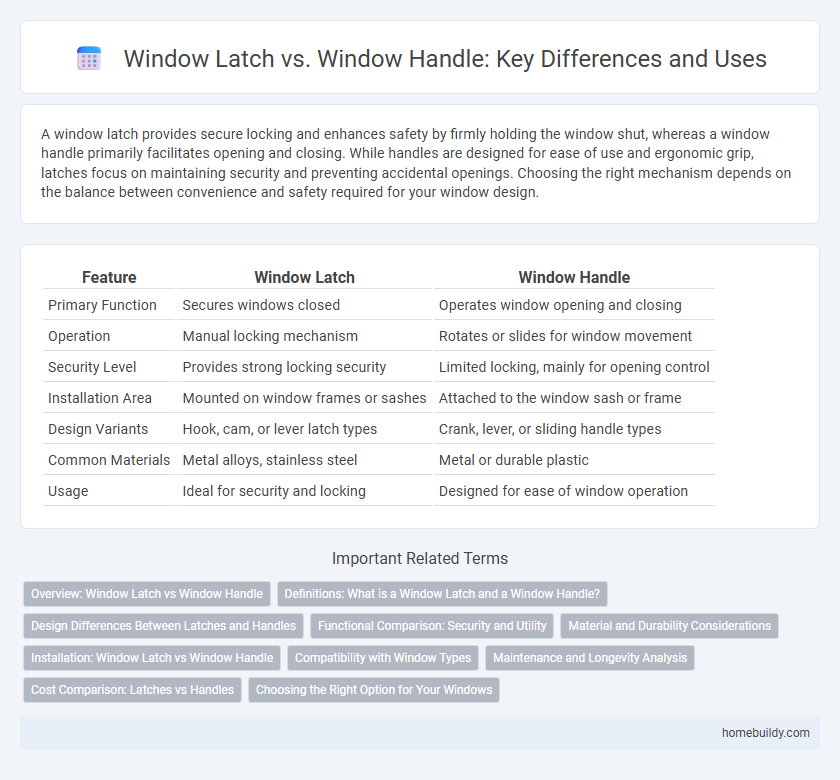A window latch provides secure locking and enhances safety by firmly holding the window shut, whereas a window handle primarily facilitates opening and closing. While handles are designed for ease of use and ergonomic grip, latches focus on maintaining security and preventing accidental openings. Choosing the right mechanism depends on the balance between convenience and safety required for your window design.
Table of Comparison
| Feature | Window Latch | Window Handle |
|---|---|---|
| Primary Function | Secures windows closed | Operates window opening and closing |
| Operation | Manual locking mechanism | Rotates or slides for window movement |
| Security Level | Provides strong locking security | Limited locking, mainly for opening control |
| Installation Area | Mounted on window frames or sashes | Attached to the window sash or frame |
| Design Variants | Hook, cam, or lever latch types | Crank, lever, or sliding handle types |
| Common Materials | Metal alloys, stainless steel | Metal or durable plastic |
| Usage | Ideal for security and locking | Designed for ease of window operation |
Overview: Window Latch vs Window Handle
A window latch secures the window by locking it firmly in place, providing safety and preventing unauthorized access, while a window handle primarily facilitates the opening and closing mechanism. Window latches often include locking features that enhance security, whereas handles focus on ergonomic design and ease of use. Understanding the distinction between these components is essential for selecting the right hardware based on security needs and operational convenience.
Definitions: What is a Window Latch and a Window Handle?
A window latch is a mechanical device used to secure a window in a closed position by engaging with a catch or strike plate, ensuring safety and preventing unauthorized opening. A window handle, on the other hand, is a component designed to facilitate the opening and closing of the window by providing a grip or lever to operate the sash or frame. While the latch primarily functions as a locking mechanism, the handle serves as a control tool for window movement.
Design Differences Between Latches and Handles
Window latches typically feature a compact, robust mechanism designed for secure locking, often operated by a simple lever or thumb turn, emphasizing functionality and security. In contrast, window handles are usually larger, ergonomically shaped for ease of grip, and designed to facilitate smooth opening and closing motions rather than providing primary locking strength. The design differences reflect their distinct purposes: latches prioritize secure fastening, while handles focus on user comfort and operational ease.
Functional Comparison: Security and Utility
A window latch provides enhanced security by firmly locking the window in place, preventing forced entry and ensuring airtight sealing, whereas a window handle primarily facilitates opening and closing without offering significant locking strength. Window latches are designed with robust materials such as zinc alloy or stainless steel, delivering greater durability compared to handles that often prioritize ergonomic design over security features. While handles improve usability with smooth operation mechanisms, latches combine utility with reinforced protection, making them essential for high-security window applications.
Material and Durability Considerations
Window latches are typically crafted from heavy-duty metals like stainless steel or zinc alloy, offering superior durability and resistance to corrosion compared to window handles, which often use lighter materials such as aluminum or plastic. The robust construction of window latches ensures long-lasting security and functionality in various weather conditions, whereas window handles may wear down faster due to less resilient materials. Choosing a window latch made from high-quality metals extends the lifespan of the locking mechanism, providing enhanced safety and reduced maintenance over time.
Installation: Window Latch vs Window Handle
Window latch installation typically involves securing the latch mechanism directly onto the window frame, requiring precise alignment to ensure proper locking functionality and enhanced security. In contrast, a window handle installation mandates fitting the handle onto the sash or window frame, often necessitating compatibility with the window's locking system and may involve additional hardware like spindle rods or locking cams. Proper installation of both components is crucial to maintain window operability, security, and weatherproofing.
Compatibility with Window Types
Window latches are specifically designed to fit various window types, including sliding, casement, and double-hung windows, ensuring secure locking mechanisms tailored to each style. Window handles primarily serve as actuators for opening and closing, with compatibility often limited to the window's operation type rather than its locking system. Choosing the right window latch enhances security and functionality across different materials and window configurations, whereas handles mainly influence ease of use and aesthetics.
Maintenance and Longevity Analysis
Window latches typically require less frequent maintenance than window handles due to their simpler mechanical design, reducing wear points and the likelihood of malfunction. The robust construction of high-quality window latches enhances longevity by minimizing exposure to elements and resisting corrosion more effectively than many window handles. Regular lubrication and inspection of window latches extend their lifespan, whereas window handles often need more comprehensive repairs or replacements over time due to their complex moving parts.
Cost Comparison: Latches vs Handles
Window latches typically offer a more cost-effective solution compared to window handles, with prices often ranging from $5 to $20 depending on material and design. Handles, which generally include more complex mechanisms and aesthetic features, tend to cost between $15 and $40, making them a pricier option for window hardware. Choosing latches can reduce overall expenses in both residential and commercial window installations without compromising functionality.
Choosing the Right Option for Your Windows
Window latches provide secure locking and enhanced safety by firmly fastening the window frame, making them ideal for preventing intrusions and drafts. Window handles offer ease of use and aesthetic appeal, facilitating smooth opening and closing with ergonomic design, best suited for frequently operated windows. Choosing the right option depends on your priorities for security, functionality, and style, balancing robust protection with convenience.
window latch vs window handle Infographic

 homebuildy.com
homebuildy.com